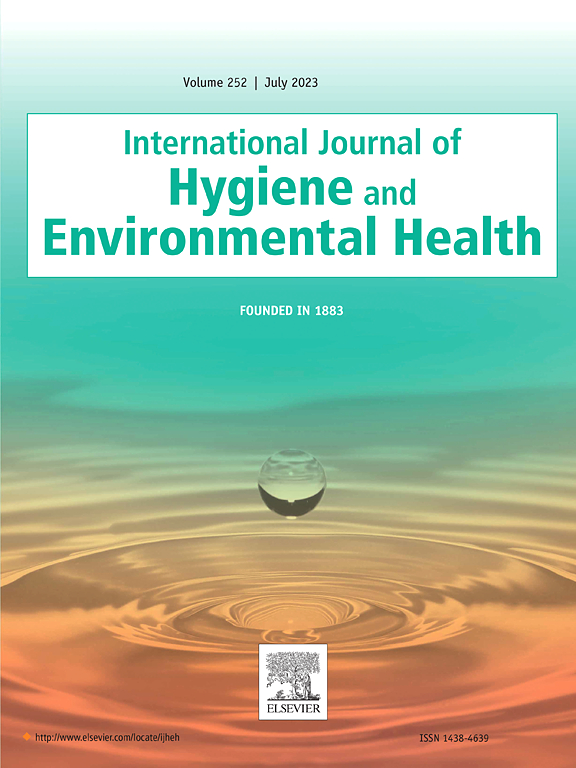Assessing the impact of per- and polyfluoroalkyl substances on pregnancy loss: An environmental-wide association study in Northwest China
IF 4.4
2区 医学
Q1 INFECTIOUS DISEASES
International journal of hygiene and environmental health
Pub Date : 2025-03-27
DOI:10.1016/j.ijheh.2025.114568
引用次数: 0
Abstract
Background
Per- and polyfluoroalkyl substances (PFAS) are emerging environmental contaminants with potential metabolic and endocrine-disrupting properties that may affect women's reproductive health. However, their specific role in pregnancy loss remains relatively understudied.
Objectives
This study aimed to assess the association between exposure to multiple PFAS and the association with pregnancy loss (PL) in a population from Northwest China using an environment-wide association study (EWAS) approach.
Methods
A case-control study was conducted at a university-affiliated reproductive center, enrolling 348 women with a history of PL and 320 controls with at least one live birth and no history of pregnancy loss. Serum concentrations of ten PFAS were quantified using high-performance liquid chromatography-tandem mass spectrometry (HPLC-MS/MS) following a standardized extraction and purification protocol. Demographic and clinical data were collected via a structured questionnaire. An elastic net regression model (ENRM) was employed for variable selection, identifying PFASs to be included in the subsequent EWAS analysis. Associations between individual PFAS and PL were then evaluated using logistic regression, and EWAS was utilized to explore the overall associations between PFAS mixture exposure and PL, accounting for potential interactions and multicollinearity.
Results
The EWAS identified five PFASs—PFPeS, PFHxS, PFOA, PFOS, and PFNA—with significantly higher exposure odds in pregnancy loss cases versus live birth controls (adjusted ORs: 1.82 [1.31–2.62], 1.34 [1.19–1.51], 1.73 [1.46–2.07], 1.33 [1.14–1.56], and 1.73 [1.40–2.15], respectively). Subgroup analyses confirmed robust associations, with PFOA consistently linked to elevated exposure odds across demographic and clinical strata.
Conclusion
This study demonstrates a significant association between exposure to multiple PFAS, notably PFPeS, PFHxS, PFOA, PFOS, and PFNA, and an increased risk of pregnancy loss in a Northwest Chinese population. The particularly robust association observed with PFOA across diverse subgroups underscores its potential as a significant environmental risk factor for PL. These findings highlight the need for further research to elucidate the underlying mechanisms and to develop strategies for reducing PFAS exposure among women of reproductive age.
评估全氟烷基和多氟烷基物质对妊娠损失的影响:中国西北地区全环境关联研究
全氟和多氟烷基物质(PFAS)是新兴的环境污染物,具有潜在的代谢和内分泌干扰特性,可能影响妇女的生殖健康。然而,它们在流产中的具体作用仍未得到充分研究。目的本研究旨在通过环境关联研究(EWAS)的方法,评估中国西北地区人群暴露于多种PFAS与妊娠丢失(PL)的关系。方法在一所大学附属生殖中心进行病例对照研究,纳入348例有妊娠史的产妇和320例至少一次活产且无妊娠史的对照组。采用高效液相色谱-串联质谱法(HPLC-MS/MS)对10种PFAS的血清浓度进行定量,并遵循标准化的提取和纯化方案。通过结构化问卷收集人口统计和临床数据。采用弹性网络回归模型(ENRM)进行变量选择,确定PFASs将被纳入随后的EWAS分析。然后使用逻辑回归评估个体PFAS与PL之间的关联,并使用EWAS来探索PFAS混合暴露与PL之间的总体关联,考虑潜在的相互作用和多重共线性。结果EWAS鉴定出五种pfas - pfpes、PFHxS、PFOA、PFOS和pfna -与活产对照组相比,在流产病例中暴露的几率显著高于活产对照组(调整后的or分别为1.82[1.31-2.62]、1.34[1.19-1.51]、1.73[1.46-2.07]、1.33[1.14-1.56]和1.73[1.40-2.15])。亚组分析证实了强相关性,在人口统计学和临床层面,全氟辛烷磺酸始终与暴露几率升高有关。结论本研究表明,中国西北地区人群暴露于多种PFAS,特别是PFPeS、PFHxS、PFOA、PFOS和PFNA与妊娠流产风险增加存在显著相关性。在不同亚群中观察到的PFOA与PFOA之间的强烈关联,强调了PFOA作为ppl的重要环境风险因素的潜力。这些发现强调了进一步研究的必要性,以阐明潜在的机制,并制定减少育龄妇女PFAS暴露的策略。
本文章由计算机程序翻译,如有差异,请以英文原文为准。
求助全文
约1分钟内获得全文
求助全文
来源期刊
CiteScore
11.50
自引率
5.00%
发文量
151
审稿时长
22 days
期刊介绍:
The International Journal of Hygiene and Environmental Health serves as a multidisciplinary forum for original reports on exposure assessment and the reactions to and consequences of human exposure to the biological, chemical, and physical environment. Research reports, short communications, reviews, scientific comments, technical notes, and editorials will be peer-reviewed before acceptance for publication. Priority will be given to articles on epidemiological aspects of environmental toxicology, health risk assessments, susceptible (sub) populations, sanitation and clean water, human biomonitoring, environmental medicine, and public health aspects of exposure-related outcomes.

 求助内容:
求助内容: 应助结果提醒方式:
应助结果提醒方式:


